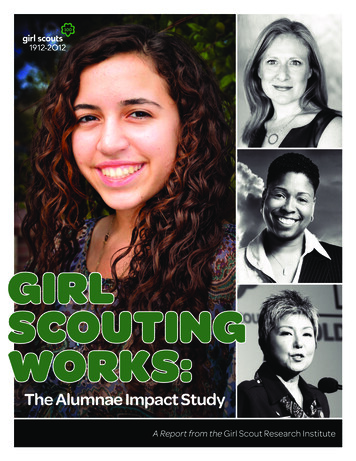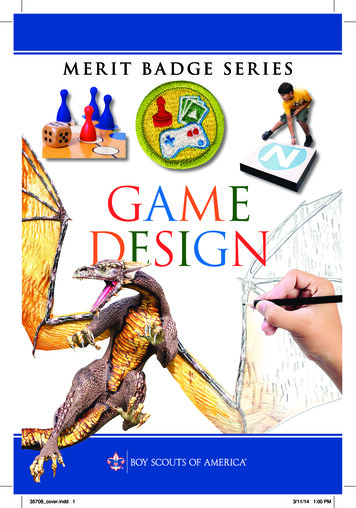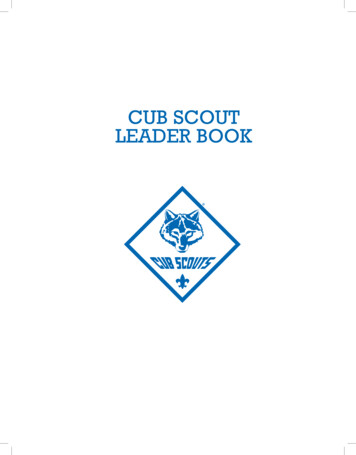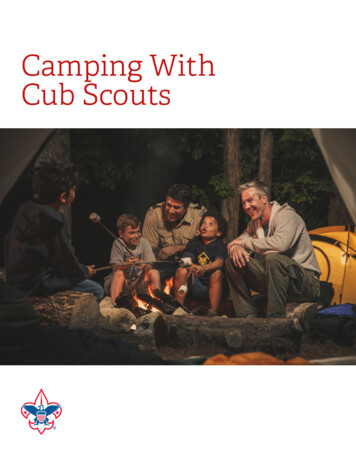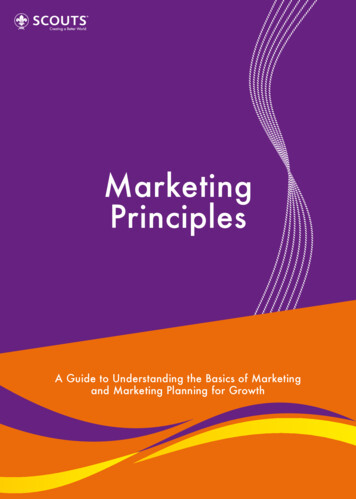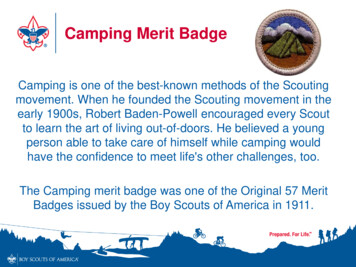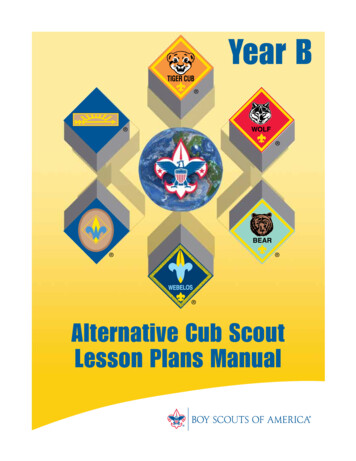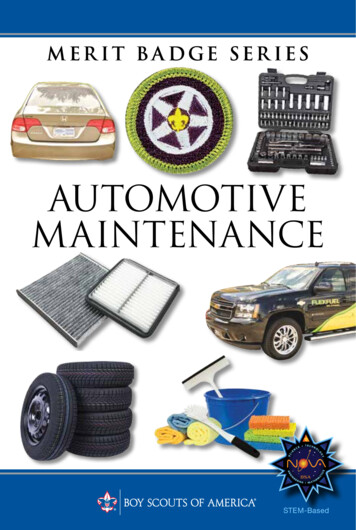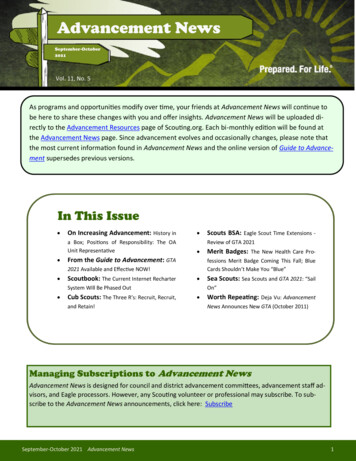
Transcription
1Vol. 11, No. 5As programs and opportunities modify over time, your friends at Advancement News will continue tobe here to share these changes with you and offer insights. Advancement News will be uploaded directly to the Advancement Resources page of Scouting.org. Each bi-monthly edition will be found atthe Advancement News page. Since advancement evolves and occasionally changes, please note thatthe most current information found in Advancement News and the online version of Guide to Advancement supersedes previous versions.In This Issue On Increasing Advancement: History ina Box; Positions of Responsibility: The OAUnit Representative Review of GTA 2021 From the Guide to Advancement: GTAScoutbook: The Current Internet Recharter System Will Be Phased Out Cub Scouts: The Three R’s: Recruit, Recruit,and Retain!Merit Badges: The New Health Care Professions Merit Badge Coming This Fall; BlueCards Shouldn’t Make You “Blue”2021 Available and Effective NOW! Scouts BSA: Eagle Scout Time Extensions -Sea Scouts: Sea Scouts and GTA 2021: “SailOn” Worth Repeating: Deja Vu: AdvancementNews Announces New GTA (October 2011)Managing Subscriptions to Advancement NewsAdvancement News is designed for council and district advancement committees, advancement staff advisors, and Eagle processors. However, any Scouting volunteer or professional may subscribe. To subscribe to the Advancement News announcements, click here: SubscribeSeptember-October 2021 Advancement News1
On Increasing AdvancementHistory in a Box“I got a call the other day from my mother. She tells me that she’s cleaning out the attic (I know!You can imagine how thrilled I was to hear this!) and she’s found boxes of my Scouting stuff. I’llbet your mom has boxes of your stuff stashed away, too. She wants to know if it’s OK to throweverything away. I begged her not to. That stuff is my history, my Scouting history, the history ofmy youth. I told her that I’d come over and we could go through the boxes together.“I won’t describe every item we found in the boxes, but I will try to hit some of the highlights. Wefound a Cub Scout uniform shirt. It must have been from the third grade because it had my Bearbadge sewn on it. I recalled that was the year my dad was deployed, and mom had helped mewith the pinewood derby car. We found my mile swim patch from summer camp. The guys frommy troop cheering me on taught me about team spirit. There was a camp staff t-shirt. Workingall summer with other Scouts who were working toward Eagle Scout encouraged me to try forEagle, too. There was a uniform shirt with my Eagle badge and JASM position badge. The stitching is a little sloppy because by that time my mother was making me do my own sewing. Also,we found my merit badge sash. Mom and I got all misty-eyed going through that stuff especiallywhen she held a way-too-small uniform shirt up to me with the Tenderfoot badge on it. In theend we decided to put it all away again to save it to show my kids.”The above story was included to illustrate how advancement is often the historical roadside marker on aScout’s journey to adulthood. Almost every Scout’s mother has a box in storage full of these markers. Themore mementos that there are in that box, the richer the Scouting experience that guided the Scout toadulthood.Embrace your history, your Scout history! Are the Scouts in your unit making exciting history? Years fromnow will their mothers get all misty-eyed going through a box of stuff. Ask yourself: “Is the advancementprogram in my Scout unit strong enough so that each Scout’s history is packed full of roadside historicalmarkers? Is every Scout building a box full of memories that will be shared with his or her mom years fromnow?”Let’s all make sure that our Scouts have rich and full histories of their journeys of growth to meaningfuladulthood with many full boxes of memories stored away. This is the one of the ways that we will fulfillour mission of keeping the Scouting movement alive for years and years to come. Now, isn’t that whatwe’re all about?Helpful LinksThe most current materials of interest for Scouters who are involved in the administration of advancement are located in one handy place, the Advancement Resources page at www.scouting.org/AdvancementSeptember-October 2021 Advancement News2
Positions of Responsibility: The OA Unit RepresentativeAs we have said previously in this series, all leadership roles in Scouting are important. Not only is leadership one of the aims of the BSA program, as well as a method of Scouts BSA, Sea Scouts and Venturing,many of these positions of responsibility also meet requirements leading toward rank advancement inScouts BSA, Venturing, and Sea Scouting.This article will discuss the Order of the Arrow unit representative, which in Venturing is considered a crewguide, and in Sea Scouting, a specialist. All three are on the list of positions of responsibility acceptable forStar, Life, and Eagle advancement, and may also be used in venturing and Sea Scouts for equivalent advancements.Order of the Arrow unit representatives serve as a communication link between their units and the localOrder of the Arrow (OA) lodge. By enhancing the image of the OA as a service arm to the unit, they promote the OA, encourage youth to take part in all sorts of camping opportunities, and help pave the way forolder youth to become involved in high-adventure programs. They arrange for OA election teams to conduct an annual OA election at a time approved by the patrol leaders’ council, crew, or ship leadership. Theyalso arrange with the unit and the lodge or chapter for at least one camp and/or high adventure promotionvisit to the unit annually. Finally, they also serve as advocates in their units for environmental stewardshipand Leave No Trace camping.You can read more about this position of responsibility at /, and you can find the support packfor the position, including job descriptions, support resources, and best methodsat pdf.As is often the case with other positions of responsibility, this position, as well asOrder of the Arrow membership itself, can play an important role in learning leadership and keeping youth in the program longer.From the Guide to AdvancementGuide To Advancement 2021 Available and Effective Now!The 2021 Guide to Advancement 2021 is out now, in PDF, and it belongs in the hands of anyone with "Youth Advancement" among theirresponsibilities—which is everyone! Get the GTA 2021 at the Guide toAdvancement website and download it now. It’s been expanded andupdated, and it’s as error-free as is humanly possible- ever! At thistime, the online pdf is the only version, they are not available at yourlocal Scout shop.September-October 2021 Advancement News3
ScoutbookThe Current Internet Recharter System Will Be Phased OutTo improve systems and increase the speed and efficiency in processes while reducing costs, the currentInternet Recharter system will be phased out. All units with a charter expiration date of December 31,2021, and beyond, will be submitted through a new system located in Internet Advancement 2.0 (https://advancements.scouting.org).This ONLY affects renewals with a charter expiration date of December 31, 2021, or later. All other renewals will continue to take place in the current Internet Recharter system (ScoutNet).More information and training materials will be released in September. See the FAQ for additional information.Connect here to see the sneak preview of the new system! The new system in Internet Advancement 2.0 will open on October 15, 2021for all charters with an expiration date of 12/31/2021. A training environment and walkthrough guides will be disbursed in midSeptember. Updated sneak peek link here: https://vimeo.com/592215637/22e21c113dCub ScoutsThe Three R’s: Recruit, Recruit, and RetainOf the six programs the BSA offers, typically over 50% of registered youth are in theCub Scout program. Annually, we recruit more first graders to be Tigers than any otherage group across all programs. In 2020, many units were unable or chose not to recruit in their communities. As a result, youth membership in the BSA plummeted.It is time for a reset this fall, so everyone is being asked to focus on membership recruitment. As critical asthat effort will be, data tells us that in a typical year we have had a problem with keeping them in the program. Voice of the Scout surveys have told us that families leave because of a poor den experience.Dens are where the action happens, it’s where we conduct activities in the form of the Adventure program.Den leaders are well meaning adults who volunteered to guide a bunch of kids through a series of activitiesContinued on page 5September-October 2021 Advancement News4
Continued from page 4to reach the goal of completing an Adventure. Our volunteer den leaders like to have a playbook fromwhich to draw and know what to do when holding a den meeting. They want to know what they should bedoing with the youth and how to get it done. Our den leaders are not child development experts, they areparents and adults who volunteer. At the beginning of each program year, our den leaders and Cub Scoutsare both stepping into the great unknown.Advancement is how we deliver our program and measure the outcome, but advancement is not the endgoal: it is a method for running a den meeting. Advancement should not define the activities to be completed; activities should lead to advancement. Cub Scouts do not have the developmental understanding ofwhy they must complete certain requirements to “advance.” They came to the meeting to have a goodtime and do something fun. Typically, that’s all the Cub Scout cares about.On the way home from a den meeting, Cub Scouts should be able to tell their families that they had FUN.They should be able to describe the meeting with glee and excitement and a need to return. If a Cub Scoutlooks out the car window and says, “That was boring,” chances are he or she will not be back to the nextden meeting or register for another program year.Our challenge is to be sure den leaders are aware of the many resources available to help our leaders provide the best program possible; each and every meeting. Let’s re-set and focus on member experiencesthat shine and provide great fun and Adventures.To find out more, aboutavailable resources, visitCub Chat Live!BSA resources available to provide the Best Cub ScoutExperience for New Membership – Youth and Adult Cub Scouting Boy Scouts of America Den Leader Resources Boy Scouts of America(scouting.org) Adult Leader Training Boy Scouts of America(scouting.org)About Advancement NewsAdvancement News is the official e-letter of the Boy Scouts of America National Advancement Program Team. Its intent is toprovide and clarify procedures found in the Guide to Advancement, announce various changes and updates in advancement,and to assist advancement committees in making decisions that can help increase the rate of advancement. Therefore, districts and councils may reprint articles from this publication. Our plan is to distribute six issues of Advancement News annually, but special editions may go out whenever there is important information to share. Feedback, suggestions, and letters tothe editor are welcome at advancement.team@scouting.orgSeptember-October 2021 Advancement News5
Scouts BSAEagle Scout Time Extensions—Review of GTA 2021Questions have recently arisen regarding the procedures to be followed by local councilswith regard to Scouts who have been granted time extensions to complete Eagle Scoutrequirements beyond their 18th birthdays.The Guide to Advancement (GTA) 2021 states that an Eagle Scout board of review may occur, without any special approval, up to 24 months after aNote that the 24-monthScout’s 18th birthday (GTA 8.0.3.1). If a time extension (pursuant to GTAgrace period after the9.0.4.0 and 9.0.4.1) has been granted to a Scout, the date of the expiration of18th birthday is newthe extension is substituted for the Scout’s 18th birthday when determining ifwith the 2021 revision of permission is needed to conduct a Board of Review. In cases where the boardGuide to Advancement; of review is to be conducted more than 24 months after the Scout’s 18th birthpreviously it was sixday or the expiration date of the time extension (whichever is later), the candidate, the candidate’s parent or guardian, the unit leader, or a unit commonths.mittee member must submit a Belated Rank Application (GTA 11.3.0.0).Time extensions of up to 24 months were available for Scouts, both male and female, who joined theScouts BSA program after February 1, 2019, and who were at least 16, but not yet 18 on that date. Theseextensions, which are no longer available, were designed to ensure that all Scouts joining the Scouts BSAprogram after February 1, 2019, would have sufficient time to complete the Eagle Scout requirements. ForScouts who were granted a time extension by the national council during this time period, the expirationdate of these extensions would replace the Scout’s 18th birthday when determining eligibility for an additional extension. Scouts who were granted such extensions may apply to their local councilfor an additional extension, if needed. Local councils have the authority (pursuant to GTA9.0.4.0 and 9.0.4.1) to grant time extensions of up to six additional months to Scouts whowere previously granted extensions by the national council, provided that they meet thethree tests outlined in GTA 9.0.4.0.For clarification, page 2 of GTA 2021 and GTA 9.0.4.1, now defines a “month.”Definition of a month: As stated on page 2 of the Guide to Advancement, a monthis a month regardless how many days it has. It is not defined as 30 days or fourweeks. For example, the maximum extension of six months means the time period beginning on the Scout’s 18th birthday up to the corresponding day sixmonths later, for example, February 2 up to August 2 or August 31 up to February 28 (or 29th if leap year). In essence, the extension expiration date acts like apseudo 18th birthday, prior to which all requirements must be fulfilled. Sixmonths does not mean 180 days.September-October 2021 Advancement News6
Merit BadgesNEW Health Care Professions MB Coming this FallIn the Boy Scouts of America, the term “merit badge” is synonymous with fun, hobbies, future careers, andnew adventures. BSA’s merit badge program was initiated at the very beginning of American Scouting in1911 with 11 original merit badges, and has continuously grown until today there are 137 merit badge subjects offered in the MB library.Over the years new subjects have been added while others have been retired, depending on societal changes, technology, and the interests of our Scouts. The current Medicine merit badge is a good example of theupgrading and modernization of the merit badge library. When the Medicine MB was first introduced in1991, it was primarily developed to focus on the “doctor” side of human health care delivery. At that time,it was considered that the merit badge would be companion to the already existing Dentistry MB [1975]and the Veterinary Science MB (originally First Aid to Animals MB [1911], later changed to Veterinary Science [1972], and now Veterinary Medicine MB [1995]).As the fields of human medicine expanded through specialization, support services, and technology, it became apparent through direction from the field that Scouts were interested in learning about other areas ofhuman health care and medical support. However, because it would have been impossible to develop anindividual merit badge for each field of interest in the health care domain, it has been decided to create asingle merit badge that will encompass a wide variety of health care careers: the Health Care ProfessionsMB [2021].Scouts working on the new merit badge will have the opportunity to learn about dozens of health care professions/vocations, including: Allopathic and Osteopathic physicians; Podiatrists; Chiropractors; Nurse Practitioners; Psychologists; Optometrists; Audiologists; Physician Assistants; Registered Nurses (and other nurses); Pharmacists; EMTs; Physical Therapists; Dietitians; Speech-Language Pathologists; Medical Technologists; Phlebotomists; as well as many others.As with all merit badges, there will be a merit badge pamphlet containing support text that describes theroles these individuals play in the delivery of health care, the settings where they may work, and any educational and licensing requirements that may be necessary.The planned release date for the Health Care Professions MB is the fall of 2021, at which time the currentMedicine MB will be retired. Scouts currently working on the Medicine MB will be allowed to continueworking on it until completed, but after the official release of the Health Care Professions MB, Scouts maynot begin working on the superseded Medicine MB. Hard copy editions of the Health Care Professions merit badge pamphlet should also be available in the fall of 2021. The style and design of the merit badge patchwill not change between the new Health Care Professions MB and the former Medicine MB.September-October 2021 Advancement News7
Blue Cards Shouldn’t Make You “Blue”Merit badges are more than learning skills. They are about Scouts exploring an interest, engaging in discussions, and being recognized. When conducted properly, the merit badge process incorporates all eight ofthe methods of Scouting.The MB process has been updated slightly in the new Guide to Advancement. The 2021 edition recognizesthat technological advances can provide many benefits, but the overall process is unchanged and the bluecard can play an important role. Alternatives to the blue card may be accepted, as long as they include thenecessary information. If electronic record-keeping methods do not encompass all the steps, blue cardsmay be used in addition. Most importantly, a Scout should always have a permanent, hardcopy record ofhis or her work.To reiterate, whether or not blue cards are included, thecomplete merit badge process must be followed, startingwith an initial discussion between the Scout and the unitleader about the specific merit badge. The Scoutmaster(or their designee) provides advice and guidance, maybesuggesting that the Scout would get more out of thebadge if they waited, or after they finished another activity. However, it is ultimately the Scout’s decision to workon a particular merit badge at a particular time.“Since blue cards support the merit badge process as it is intended to function, the Guide toAdvancement continues to reference and recommend them. It is expected that when bluecards are not used, advancement administrators at all levels will find ways to carry on theprocesses, interactions, documentation, andother nuances that make the process such acritical element in BSA mission achievement.”During that initial conversation the unit leader shouldGuide to Advancement: Section 7.0.0.2 – Aboutthe Application for Merit Badge (“Blue Card”)provide contact information for at least one councilapproved merit badge counselor. However, if the Scouthas one already in mind, they must be allowed to work with the registered and approved counselor oftheir choice. This initial meeting is integral to the merit badge process, and as such should be documentedby the leader signing the blue card, or by other means.The Scout next contacts the merit badge counselor, following all Youth Protection Training guidelines, andbegins the process of completing the requirements. The counselor can consider work done at any timeafter the Scout was a registered Scouts BSA member, as long as the Scout actually and personally completed the requirement, as written.As the Scout completes requirements, the merit badgecounselor documents each by initialing and dating thespaces on the blue card, or other method. These“partial” completions do not expire until the Scout’s18th birthday. The Scout may choose to finish the merit badge with a different counselor, who should acceptthe previous counselor’s certification of any requirements completed.Continued on page 9September-October 2021 Advancement News8
Continued from page 8When all requirements are complete, the counselor records that information on the blue card, and/or byelectronic means. The counselor should retain the “Counselor’s Record” portion of the blue card for at leastone year, in case questions arise.After all requirements are completed and approved by the counselor, the Scout shows the evidence of completion to the unit leader, who initiates a discussion on how it went, but does not retest the Scout. The unitleader documents this discussion as well, then the troop reports the completion to council and presents theScout with the merit badge.Each time the Scout must obtain a signature it is an opportunity for a growth-oriented, positivedialog that may provide inspiration and direction, and possibly a different perspective on thesubject of the badge. This association with adults provides counseling, instruction, and learningexperiences that are an important part of the advancement process. The signature is verificationthat the conversation has taken place, whether it is digital or on a blue piece of cardstock.Sea ScoutsSea Scouts and GTA 2021: “Sail On”The new edition of Guide to Advancement may be out, but this is a sea story about the oldways of Sea Scout advancement – which have not changed, even if some of the terminology has (GTA4.4.0.0). If you are unaware, or your memory is rustier than a 50-year-old sailboat, regarding how Sea Scoutsadvance, dive in.When a youth joins Scouts BSA at age 10, or when the Arrow of Light Rank in Cub Scouts has been obtained,the Scout can advance at his or her own pace. The key in timing, is with completion on the work on the Eaglerank before the 18th birthday. Eagle Board of Review follows. For GTA 2021 guidelines, see the earlier articlein this edition of Advancement News.When a youth joins Sea Scouts at the age of 14, he or she advances through the ranks of Apprentice, Ordinary, Able, and Quartermaster. Sea Scouts have until the day before their 21st birthday to have their Quartermaster Board of Review (formerly Bridge of Review). In Sea Scouts, the QuartermasLast year, BSA recordedter is the top rank. While thousands earn Eagle each year, only 40 or so Sea Scouts47,577 Eagle Scoutsearn the Quartermaster rank annually!When a Scouts BSA youth is ready to perform an Eagle service project, he or she must go through a district’sEagle advancement representative, and the project must be approved by that person on the district level.The same requirement applies to a Quartermaster project, which is considered the Sea Scout equivalent ofthe Eagle rank. To get their Quartermaster Project approved, candidates must go through the same Districtperson that Eagle candidates do to get their Quartermaster service project approved.Continued on page 10September-October 2021 Advancement News9
Continued from page 9Formal processes aside, what a lot of people do not realize is that Scouts can work on becoming Eagle whilealso being in a Sea Scout unit. Sea Scouts is a High Adventure wing of the BSA, so all the things that apply inScouts BSA also apply in Sea Scouts. When you think about it, a lot of what is earned in Scouts BSA is appliedin Sea Scouts – swimming, lifesaving, canoeing, first aid, shooting sports, maps, camping, cooking, youth protection, leadership training, and, of course, sailboats employ the knots Scouts BSA members learn and perform for rank advancement. So, you can work on your Eagle in a Sea Scout unit – called a ship -- work onyour Sea Scout advancements in the ship, or work on both.But perhaps the best thing about Sea Scout advancement is that the Sea Scouts program keeps youths in theBSA longer. In fact, studies show that youths stay in the BSA about 2.5 years longer if they are in a High Adventure wing of the BSA, like Sea Scouts.Worth RepeatingDeja Vu: Advancement News Announces New GTA(October, 2011)This is the 10th anniversary of the very first issue of Advancement News. This brief article describes thatvery first issue.The highlight article in the October 2011 inaugural edition of the Advancement News was the introductionof the new Guide to Advancement. The BSA publication had been completely rewritten from previouslyavailable materials. A major improvement was the innovative section numbering system to allow users toeasily locate references to the many advancement topics.Many informational topics were started in that inaugural AN edition: A new Eagle Scout Service Project workbook was introduced. An article about “Who hears national Eagle Scout Rank appeals?” was provided, where the procedureswere outlined from the local council to the National Advancement Team and the Eagle Issues Taskforce – a body of experienced Scouters, who are still providing this function. The publication began exploring advancement committees and their various functions. National training opportunities related to advancement were promoted. New (for 2011), the Chess Merit Badge was introduced on September 7th. Survey questions were presented and designed to identify issues so that Scouters working in advancement could share their opinions.Today, Advancement News continues to be a publication of the Boy Scouts of America via the professionalstaff. The contents, however, are generally provided by the many volunteer authors and editors who areScouters of experience, and who thank all of our readers for your support. Comments are always welcomed at advancement.team@scouting.org.September-October 2021 Advancement News10
the most current information found in Advancement News and the online version of Guide to Advance-ment supersedes previous versions. Advancement NewsAdvancement News September-October 2021 Vol. 11, No. 5 On Increasing Advancement: History in a ox; Positions of Responsibility: The OA Unit Representative From the Guide to Advancement: GTA

